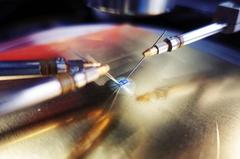View of the proton beams (marked in red) colliding in the center of the CMS Experiment at the LHC at CERN (image: CERN).
Experiments at the Large Hadron Collider LHC at CERN explore the very basic elements of the Universe and their interactions at ever-increasing precision. At the precision frontier, new particles or forces beyond the standard model of particle physics could be discovered as small but significant discrepancies between theoretical predictions and experimental observations. With major contributions from DESY physicists, the CMS collaboration at the LHC has now published a new measurement of a crucial value, the so-called integrated luminosity, taking precision to a new level.
At the LHC, particle beams containing billions of protons collide at very high energy and high luminosity. Luminosity is a measure for the collision rate; the more protons there are, and the narrower the beams, the higher the luminosity. For experiments to be successful, it is not only important that the luminosity is as high as possible, but it is also essential that its number is known as precisely as possible. So far, typical uncertainties for the luminosity at high-luminosity and high-energy experiments such as CMS were about 2.5 %, a value already significantly better than originally deemed possible.
The CMS collaboration has now divided this number by another factor of two: their new luminosity measurement with an uncertainty of 1.2 % is the most precise result at a high-energy and high-luminosity hadron collider experiment. The result was produced by a team of physicists and Ph.D. students at DESY, CERN, the Universities of Princeton, Budapest and Kansas. “Credit for this leap in quality goes especially to the Ph.D. students and PostDocs who developed ingenious and new methods, and tenaciously performed all the studies that shrunk the uncertainties to this unprecedented level”, says Andreas Meyer, DESY scientist in the CMS group. The new measurement marks a milestone in the quest for precision measurements at hadron colliders. It is also a proof of feasibility for the declared goal for the High-Luminosity-LHC era starting in 2027 to measure the luminosity to a precision of 1 %.
The full factor of two in precision is picked up by the most recent CMS measurement of the production of Z-bosons, messenger particles of the weak force. “With the new measurement more stringent experimental constraints on theory predictions become possible”, says Joscha Knolle (Univ. Gent), former Ph.D. student at DESY, and taking over in Fall 2021 as co-convener of the CMS luminosity working group.
In the CMS experiment, several luminosity detectors of different technology are used for redundancy and uncertainty reduction. For the precision measurement of the luminosity, the team took data recorded in 2016 and analysed them in detail. The next milestone in the quest for precision will be to apply the newly developed methods and insights to the data of the years 2017 and 2018. In parallel, the next LHC data taking period, Run-3, is being prepared. For Run-3, DESY constructed and tested electronics and sensors for the refurbished Fast Beam Condition Monitor, BCM1F, a luminosity detector based on silicon pad diodes. The lessons learned in this pilot paper are the foundation to improve further, to exploit the LHC to the fullest extent, and to push the precision frontier to the limit.
Article about the luminosity measurement on the CMS website
Reference
CMS Collaboration, „Precision luminosity measurement in proton-proton collisions at √s=13 TeV in 2015 and 2016 at CMS“, submitted to EPJC, arXiv:2104.01927









